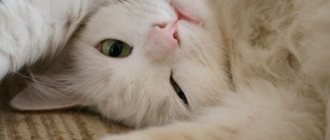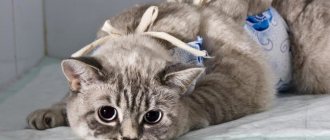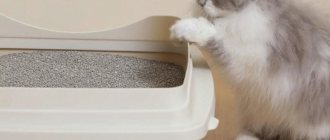Can a cat mark like a cat?
Many people choose to have cats because they believe that they are not capable of marking at home. Males of the feline regularly “mark furniture” after puberty and during the hunting season, but girls are also capable of doing this.
Often, inexperienced owners can confuse the marks and a normal trip to the toilet outside the tray.
Externally, cats mark objects like cats: they stand with their backs to the object, twitch their tails and secrete a small amount of a pungent-smelling liquid.
How quickly does estrus return after childbirth?
About 64 days pass from the date of first mating to birth. Then the cat feeds the kittens; the duration of this period largely depends on the owners. 10-14 days after the end of lactation, estrus resumes.
Cat feeding kittens
The problem is that some lactating cats go into heat as early as 2 weeks after giving birth. If mating with the cat does not occur at this moment, then the cat begins to walk, as before, every 10-20 days.
If mating occurs, fertilization is unlikely due to the fact that the uterus has not yet recovered from childbirth. But mating during the next heat can be effective, so you can often see a nursing cat already pregnant with a new litter.
Is it all because of heat?
Upon reaching the age of 6 - 8 months, hormones begin to rage. The reproductive instinct awakens and the search for a partner begins.
If an uncastrated cat lives nearby or in the neighborhood, then the cat will try to attract his attention as much as possible with the help of loud screams and marks.
During heat, it is necessary to protect her as much as possible from potential meetings with suitors.
The most common cases are when a cat shits during heat, but the following may also be the cause:
- Veterinarian intervention or sterilization: the cat marks as a result of stress. You need to leave the animal alone. Perhaps this problem will resolve itself. If the situation with the tagged property drags on, then you need to consult a veterinarian who can offer sedatives.
- Developing pathologies in the genitourinary area. - This can be cystitis, pyelonephritis, formation of stones and sand in the kidneys and ureter. In such cases, the act of urination becomes painful, and the tray begins to cause unpleasant associations. This may prompt the cat to look for another place that, in its opinion, causes less painful sensations, marking it along the way. A loving owner is obliged to show the cat to a veterinarian for consultation and further treatment;
- The arrival of a new family member or pet. The cat may perceive such an “innovation” as a threat to its territory. Instinctively, she marks everyday objects, showing dominance. If this is a person, then you need to give time to get used to each other. When a pet appears, the best solution is to temporarily isolate them. It happens that when leaving, owners are forced to leave the cat with strangers. Marks in such cases can be a sign of protest
Age at first estrus in cats
It is impossible to definitively answer the question at what age these animals begin to mark their territory. This depends on many factors: the breed, the personal qualities of the pet, the predisposition of its body, the speed of development. In 75% of felines, puberty occurs at 7–8 months. It is from this moment that they begin to mark the territory that they consider theirs.
If the cat begins to mark surrounding objects in the house, it means:
- he experiences sexual desire and tries in this way to attract a partner for mating;
- he lacks the attention of the owner;
- the pet is in a state of fear or stress;
- the animal is feeling unwell;
- the cat is jealous of the owner;
- The tailed inhabitant of the house is fighting for his territory.
For most cats, the first heat begins after the female reaches a weight of 2.5 kg. This rule does not apply to large breeds such as Maine Coon or British cats.
The age of puberty ranges from 4 months to 1.5 years. Most often, a cat first begins to ask for a cat at 6-9 months. This age depends on several factors:
- Heredity.
Some cats are more temperamental than others, and some, on the contrary, are late maturing. In mixed breeds, the onset of the first heat is difficult to predict in advance, but among purebreds, patterns have already been identified.
The fastest maturing are the short-haired “oriental” breeds - Thai, Siamese, Burmese, Abyssinians, Bengals, Cornish Rex. On the other hand, cats of long-haired breeds sometimes begin to walk at 10-12 months and later - Persian, Maine Coon, Siberian.
Young cat of the Bengal breed
- Daylight hours.
March cats are not a fiction. Increasing the duration of daylight hours encourages the onset of estrus. If the cat is six months old in the spring, you should expect the onset of estrus soon. If the same age falls in October-December, then the onset of estrus is more likely only next spring.
In an apartment, this dependence hardly manifests itself due to constant heat and constant artificial lighting.
- Conditions of detention.
Exhausted cats lacking vitamins and fats do not go into heat. Therefore, street animals mature later than domestic animals, and their estrus occurs less frequently.
- Communication with relatives.
The presence of another cat in heat or an unneutered cat provokes the onset of heat in young teenage cats.
To delay the onset of the first heat as much as possible, the owner needs to keep the cat isolated in the apartment and turn on the light for no more than 4-6 hours a day.
More reasons why a cat marks territory
In addition to the main and common reasons, there are many prerequisites for a cat to start marking your home:
- Moving. Instinctively, a cat explores and marks a previously unknown territory as a cat, thus protecting it from the encroachments of other animals. In such a situation, it is worth being patient. Over time, she will calm down and the desire to mark will disappear.
- Other cats leave marks on the front door. The problem often arises among owners of private houses. Foreign odors cause stress for your pet, prompting you to mark the furniture.
- Crowded housing of a large number of animals in a cramped room. Cats are by nature territorial creatures: just as street fighters take their places in the hierarchy, so a pet will strive to win a place in the sun by marking the boundaries of its territory. The more living creatures per square meter of an apartment, the higher the likelihood of marks occurring.
- Physical violence - when a cat is squeezed against its will, or, even worse, harsh methods of punishment are used for misdeeds. She is under constant stress, which prompts her to mark for self-soothing purposes. Owners are advised to reconsider their attitude and parenting methods.
- Excessive spoiling of a pet is the other side of violence, when the cat’s misdeeds get away with it. Over time, the owners realize that it is time to start raising their pet. Punishment or refusal to do something, such as giving food from the table, can cause protest. She begins to aim to harm her owners.
Duration and frequency of sexual heat
Characteristic behavior lasts from 3 to 10 days. The period when a cat is in sexual heat and allows a cat to approach her is called estrus. At this time, the ovarian follicles produce the maximum amount of estrogens and sex hormones.
In the very first days of estrus (1-4 days), the cat demonstrates sexual arousal, but does not allow mating. This time is called proestrus, “forerunner”. Unlike dogs, cats do not have a clear boundary between estrus and proestrus, and it is difficult to determine these periods.
If sexual intercourse does not occur during estrus, then ovulation does not occur. In this case, sexual heat returns every 10-14 days. The period between estrus is called interestrus, this is a time of rest for the uterus and ovaries. In some cats, the concentration of estrogen in the blood does not decrease, and the animal walks constantly.
Prolonged heat is a sign of follicular ovarian cysts, which must be removed surgically.
Complete rest of the ovaries, which means the absence of the reproductive instinct, is called anestrus, the absence of estrus. In stray cats, this period occurs in late autumn or winter, due to short daylight hours and the action of the hormone melatonin. Anestrus does not occur in domestic cats due to constant light and nutritious food.
A distinctive feature of the breeding system in cats is induced ovulation. Simply put, an egg is released from the ovary only in response to vaginal stimulation. Natural ovulation occurs due to mating, but artificial ovulation is also possible - as a result of manipulations in the vagina.
Ovulation occurs 1-2 days after intercourse, and after another 1-2 days the estrus stops. The ovary forms the corpus luteum, which produces the hormone progesterone to maintain pregnancy.
If the egg is released and fertilization does not occur, progesterone will be produced “by inertia” for 1-1.5 months (less than a true pregnancy). Progesterone prevents the resumption of estrus.
We suggest you read: How to cure acne in cats
In cats, sexual function does not decline until death; even at 16-19 years of age, estrus is observed from time to time in non-sterilized animals.
I'm 14 years old, motherfucker, how old can you be?
What to do if your cat starts marking: how to wean it off
If a cat systematically marks, this should not go unnoticed. First of all, it is necessary to identify the reason for this behavior.
- If your cat marks during heat, you should consult your veterinarian, he will suggest medications to suppress hormonal levels. It is strictly prohibited to abuse such substances; they have many side effects.
- For preventive purposes, if the pet does not have breeding value, it is strongly recommended to sterilize it during puberty. The sooner this procedure is carried out, the greater the likelihood that the cat will stop marking after sterilization, but do not delude yourself, there are no guarantees.
- The use of violence is highly discouraged. The best way to stop a cat from marking is to shout loudly, clap, or use a spray bottle inconspicuously. Punishments should be systematic and immediately after she has done something dirty. Otherwise they have no effect.
If a fresh tag is detected, it must be removed quickly and effectively. Rinse off the discharge with clean water, then wipe the area with a cloth and vinegar.
Acetic acid will help remove unpleasant odors, and its aroma will be irritating to the animal. You can secure the result with a veterinary spray to eliminate odors, or repellents such as antigadin.
In places where the cat has begun to mark, you can place cotton wool soaked in vinegar. However, many people do not like this smell, and it can be replaced with citrus or clove essential oil.
Such measures will help discourage the desire to label interior items in the apartment. The most important thing is to be patient, and the result will not keep you waiting.
What to do?
Castration or sterilization is the most popular answer to the question of what to do if a cat marks the territory in the house. But after the procedure, the hormonal system takes a long time to rebuild, so the appearance of marks may continue.
You can try to limit tagging using less drastic methods:
- use herbal sedatives;
- Place citrus peels in the marked areas; cats that are sensitive to odors do not like their essential oils;
- purchase special repellents at a pet store;
- if space marking is caused by stress or fear, try to eliminate the cause and pay more attention to your pet.
- Having caught the mischievous pet in the act, lift it by the scruff of the neck to face level, hiss, and lightly flick it on the nose. While doing all this, look into your eyes and show your dissatisfaction in every possible way. Continue until the cat begins to meow pitifully and avert his eyes.
Unfortunately, there is not a single 100% method on how to wean a cat from marking territory in an apartment. Each method is only partially effective.
Marks or shits
There are four types of soiling, each of which will not please the owner:
- Urine odor marks.
- Marked by the smell of feces.
- Urinating in the wrong place.
- Defecation in the wrong place.
Before you "draw your guns" and start fighting, make sure you've pinpointed the problem! First of all, make sure that the cat is healthy, especially if she has always gone to the litter box and suddenly started getting dirty. A cat will never shit (cause an unpleasant odor) of its own free will; this must be accepted as an axiom!
The mark is the animal's scent identifier. It's no secret that an adult cat marks its territory regularly and very abundantly, but do cats mark? Definitely yes, but less often and for more compelling reasons.
Not many people know how cats mark territory. It is generally accepted that the marks are only urine. In fact, animals additionally mark their territory with secretions (liquid) that are secreted between the fingers and from glands located in the area from the corner of the lips to the base of the ear. The smell of feces is also suitable for tags, fortunately, it is not used often. To summarize, a cat or tom marks territory when:
- Leaves traces of urine; the cat lifts its tail and shakes it, at which time streams of urine “irrigate” the desired area.
- It rubs its muzzle against the legs of tables, doors and openings, the owner and his things.
- Sharpens its claws on scratching posts, furniture, wallpaper, window frames, doors and openings, floor surfaces.
It is believed that only cats mark... but this is not true. All animals (dogs, rodents, mustelids) leave scent marks. Males a priori take on the function of protecting the territory, so they mark more abundantly. A cat may mark while in heat, stress, or motherhood.
When a beloved cat (and females are prone to this) begins to make puddles on the owner’s bed, we can say that the problem has reached the top of Everest. Usually, the owner comes to the conclusion that the cat has gone crazy and decides to get rid of it. This is justified like this: “she needs to live in the private sector, on the street”, “she does it out of spite”, “she doesn’t love/hates me”... but the situation is just the opposite.
Unspayed and neutered cats urinate in the bed with equal success, since eliminating sexual heat does not eliminate the real cause. The reason is the cat’s dependence on the hormones of joy that it receives when communicating with you. Yes, being overly affectionate on your part encourages your cat to pee on your bed. Let’s make a reservation right away: changing mercy to anger will not help, but will only worsen the problem!
When a cat pees on your bed, it asserts that it is one with its owner: “you are a human and I am a cat, there is a single individual, we are so close that I have the right to mark your private place with my smell.” How to stop a cat from peeing on the bed? The only way out is to establish balanced, harmonious, healthy relationships.
In the lack of attention from a specific family member. In the fact that the “bad” is rude to a beloved family member. In the fact that the “bad” receives all the attention of a beloved family member (most often a child).
This situation can be interpreted as a cry of indignation, especially if the act of urination is performed in front of the owner
To solve a problem like this, you need to be even more careful. A sharp reaction on your part will be understood as “falling out of love, abandoned, found a replacement” and acts of attracting attention (peeing on the bed) will only intensify
Disease
The cat marks as if to spite its owner. They did everything to her: they scolded her, spanked her, and poked her nose. No, he doesn't understand. Runs away from the crime scene on half-bent legs, with blocked ears. But he continues to do his job.
Do not rush to scold your favorite. Perhaps the whole point is that the animal simply does not always have time to reach the tray. If a cat has cystitis or urolithiasis, punishment will not help. The animal must be treated; this is impossible to do at home. Therefore, you will have to take your pet, put it in a carrier and rush to the veterinarian. The faster, the better for everyone. Because only a specialist can determine the presence of diseases associated with the bladder.
Is the cat shitting? We find the reason - we solve the problem!
For many animals, the main language of communication is smell.
Felines mark their territory by placing odorous marks on its borders. This is a self-preservation instinct that warns strangers that this place is already occupied. Nothing good awaits anyone who violates the border - he will be attacked. Domestic cats follow their innate instincts; their habitat is the owners’ apartment. When an animal goes to the toilet, it simply sits down, releasing a fairly large amount of urine. If the cat decides to mark an object, it approaches it, trying to find a vertical surface, and stands with its back to it, straightens or bends slightly, raising its tail. During the process, the tip of the tail trembles. Everything happens very quickly - the animal sprays the object with a jet directed in a horizontal plane.
Cats try to mark with their presence all objects on the site or in the apartment
It is very simple to distinguish a mark from urination: a small predator marks using only 1–2 ml of liquid. During excretion, urine mixes with secretions from the glands located next to the genitals, so the liquid has a distinct odor.
Cats have a slightly different behavior pattern. This rarely happens to them. This reaction can be provoked by the appearance of other animals in the house. Since the cat is a territorial animal, it will do everything to make the new owner feel who is boss. Cats may mark their boundaries differently.
Sometimes cats rub their entire body and tail, where there is also secretion from the glands.
While the kitten is still small, owners should not worry. Problems begin at puberty. This happens when the cat is 6–8 months old (the exact time depends on the breed). Unfortunately, it is impossible to prevent this process, but the accomplished fact should be stated in a timely manner.
There is a lot of information in the media that you need to place cat food near the marking areas, and in a few days the cat will forget about his marks. In combination with the use of food, the tags should be destroyed so that their smell does not attract the cat. The author tried to use this advice in practice. As a result, the cat began diligently marking other places and objects. The food laid out in the rooms, instead of having a beneficial effect, stimulated the mustachioed lover to gluttony.
READ How to switch a cat from dry food to homemade food
If gentle methods do not work and you want to use a potent hormonal drug, it is better to first consult a doctor.
Unfortunately, it is impossible to eradicate the desire of cats to continue their race. The author of these lines raised his baby according to the above rules. As a result, it was only possible to reduce the desire to reproduce when Manyunya (that’s the cat’s name) felt sexually mature. Screams along with marks echoed throughout the house.
Castration is a surgical procedure that removes the internal genital organs of a male cat. In cats, both testicles are removed; in cats, both testicles are removed. As a result, the hormones responsible for the animal’s sexual activity cease to be produced. The little furry begins to pay more attention to its owners, becomes kinder and more affectionate.
Statistics show that castrated cats get sick less and live longer.
We figured out why cats mark, now let’s look at why pets “get dirty” or shit. The behavior correction methods given below are also valid for animals that mark, but they will not solve the problem.
Symptom of the disease
Cystitis and problems are common. It is painful for the pet to urinate and he in every possible way avoids the place where discomfort overtakes him. Most often, cats begin to go to the toilet next to the litter box (in the same room). If the pet is healthy, but relieves itself next to the tray, she “says” that the tray:
- Inconveniently located.
- Unsafe - the tray must be stable, high enough, protected from the views of people and animals. A tray with a grate or loose filler may seem unstable.
- Small.
- It smells bad.
It is believed that if a neutered cat marks its territory, this is an unsolvable problem. Firstly, there are no unsolvable problems, and secondly, are you sure that the cat is marking and not shitting? Cats are naturally very clean and prefer to relieve themselves in one place. Reasons for ignoring the tray may include:
- Age - some kittens forget or do not reach the litter box and this is normal. Statistically, a kitten begins to reliably relieve itself in an approved place at the age of 3–4 months.
- Cleanliness of the litter – adult cats need to change or “refresh” the litter tray at least once every 3 days, and preferably every day!
- Type of filler - try changing the tray filler or leaving the mesh bare. If a cat is declawed, it may be painful for her to step on sand.
- Tray size – an adult cat should be able to turn around freely in the tray.
- Tray designs - there are trays with roofs and open ones, with and without nets.
It has been proven that cats see the green and blue spectrum of color. The color red appears gray or light gray to the cat. Cats associate black and dark gray colors with a hole in the floor or an abyss. Does your cat have a new dark or red litter box? Ignoring it is quite justified.
READ When do ducklings hatch?
With timely castration, you will not encounter such a problem, but if time is lost... About six months after castration, the cat no longer needs to leave marks and if he does this in front of you, it is a matter of habit. Habits to win are more difficult than desires, since cats are characterized by constancy. The space limitation method is suitable for those who do not have time to constantly monitor their pet.2
All cats mark their territory. Cats do this when they are in heat and may scatter excrement when they leave a mark. In addition, this happens more often, since girls are very sensitive to scents and do not tolerate the smell of foreign animals.
The desire to mark its possessions arises in a cat for various reasons. Before you wean her off a bad habit, you need to understand why it happens. Among the main factors are:
- Territory threat – a cat perceives a new person or pet as a threat to its personal space. Since she does not want to share her favorite places, she will actively fight for them. Therefore, when a new animal appears, it needs to be allocated a separate place in the apartment. If there are no strangers in the house, but the pet still marks the territory, perhaps another animal has marked the space next to the front door. In this case, you need to drive away the stranger and eliminate all traces of his presence.
- Diseases - if your furry pet walks past the tray, it may develop cystitis or urolithiasis. It hurts the cat to pee, and the litter box is associated with unpleasant sensations, which is why she looks for another place. In such a situation, the animal needs to be urgently shown to a veterinarian.
- A change of environment or stress - moving, renovation or other factors force the pet to mark a new environment. Similar consequences are observed after sterilization. To solve the problem, you need to give your pet a sedative or wait until she gets used to the changes.
- Estrus or sexual heat - if a cat senses the close presence of the opposite sex, it begins to mark very strongly. At the same time, they fear that the cat may take over her territory. You can wean your pet off a bad habit only if there are no potential sexual partners nearby.
Changes in a pet's behavior during the period of sexual heat are considered normal; the cat undergoes a hormonal restructuring, which greatly affects its habits. The animal may become aggressive or, conversely, more affectionate. Most of them meow constantly and loudly, regardless of the time of day, and mark their territory.
Cat owners share their experiences
All cat owners who have extensive experience communicating with their pets unanimously say: cats should be raised from the first day of their appearance in the house. Lack of attention to a furry friend is simply unacceptable - the kitten does not develop, withdraws into itself and becomes a recluse. The educational process best takes place in a playful way.
You need to talk to your baby in the same way as you would to a small child. Fluffy feels the attitude of his owners very well and tries to repay their love with gratitude. At the onset of puberty, most cat owners recommend castration. It is believed that this is better than hormonal effects. The main advantage: castration has much less impact on the cat’s health.
In general, each owner has his own tactics, developed from his own experience. Much also depends on the character of the animal, because each cat has its own unique behavior pattern.
Brief abstracts about estrus in cats: everything you need to know
A reminder for anyone who adopts a female kitten:
- Puberty occurs at 6-9 months.
- On average, estrus lasts a week and, in the absence of mating, repeats every 2-3 weeks.
- The only way to calm a cat is to induce ovulation with a special massage that simulates sexual intercourse.
- The use of hormonal agents or surgical sterilization should be considered before the onset of estrus.
- Repeated “empty” periods of sexual heat cause diseases of the genital organs - ovarian cysts, pyometra, hydrometra.
Now that you know how long a cat’s heat lasts and how difficult it is to calm a pet, let’s move on to the main thing. Sterilization is the most favorable option if you do not plan to regularly breed a cat and get kittens from her. Read about this operation in a separate article.
Stress factor
Your cat is sterilized and marks corners in the apartment. How is that? The indignation of the owners is understandable; it is simply impossible to tolerate the disgusting smell. Do you really have to get rid of the animal if nothing helps?
Wait. Let's try to understand the problem. Remember, was there a situation at home that could affect the cat? Maybe friends with a dog came to visit? Or did little guests come to the children who wanted to meet the beautiful purr? Or did your pet’s food suddenly change?
It would seem that these are very minor factors. This is real stress for you and me, but for the cat. Imagine, she lies there, not bothering anyone. And then a dog’s face came out of nowhere. And he smiles from the top of his dog’s mouth. Naturally, the cat’s eyes will widen, as they say, and it will start looking for the fifth corner in the apartment, just to escape from the monster. And then the body “discharges” in such a non-standard way as marking the territory. Because he was stressed.
How to get rid of cat marks
Cat marks appeared as a way of communication between cats living in nature.
Cats are territorial animals and by leaving their specific scent, they claim territory.
It is believed that with the help of marks, cats let other cats know that they have been here. Moreover, by the intensity of the smell of the mark, cats can determine how long ago an opponent passed through the territory.
First of all, you need to find the marks: sometimes this can be very difficult to do. You can use an ultraviolet lamp - cat urine glows in ultraviolet light.
When a tag is detected, we take action. If your cat marks the floor, wall, or other washable object, the first step is to wash off the mark with clean water. Then wash the floor with a 10% solution of enzyme detergent and wait until it dries. After drying, treat the area with special odor removing agents containing enzymes (such as Nature's Miracle) or rubbing alcohol. Laina also copes well with the smell of tags.
Do not use bleach or chlorine solutions to clean floors! Bleach is toxic to cats and does not remove the smell of urine; on the contrary, it makes it even more disgusting.
If the cat has marked the carpet, treat it with a washing vacuum cleaner. The principle of operation of a washing vacuum cleaner is that the coating is saturated with water, and then the water, along with contaminants, is sucked back and drained. Never use steam cleaners! Hot steam will only embed the odor even deeper into the fibers of the coating.
If your cat has marked clothing or other fabrics, soak them in cold water for several hours as soon as possible. The longer urine sits on the fabric, the more difficult it is to get rid of the smell. You can add a glass of table vinegar to the soaking water. The first step is to dissolve and remove as much urine as possible from the fabric. For washing, use powders with enzymes or soda - they dissolve biological contaminants best.
If the smell remains after washing, soak the items overnight in a more concentrated vinegar solution and wash in warm water. You can add a special enzymatic odor remover to the powder.
To prevent further incidents, place bowls of food or treats in the areas where your cat has marked. The animal will not mark where it eats.
If you have several cats, make sure that everyone can use the tray, scratching post, hiding places, toys, and that everyone has free access to food and water, and to the toilet. Such a house should have several trays, preferably in different places.
There is a definite difference between marking territory and relieving yourself in undesirable places. Now we will talk about the main signs of tagging:
- Cats always use their litter box for its intended purpose, but they also leave urine in other places.
- Tags are most often located in certain places
- The cat can stand on straight legs with its tail raised or squat on its hind legs
- Urine is most often found on vertical surfaces (walls, corners of the sofa, etc.)
- Urine can be on horizontal surfaces (most often on the sofa, shoes, clothes)
- Tags do not appear every day, but periodically
If your cat does not use the litter box at all, and only urinates or leaves feces, then your problem is most likely not related to marking the territory. In this case, further advice will not help you.
You should also visit a doctor and rule out the presence of a urinary system disease, in which the cat may have difficulty going to the toilet, leaving small puddles that can be confused with marks.
Tag prevention
To prevent the appearance of marks in the house, experienced breeders and veterinarians recommend using the following measures:
- Emasculation. An effective method of preventing the appearance of marks, only if the operation is performed before the onset of puberty.
- Proper education. This is not the most effective method, because if leadership qualities are inherent in a cat’s nature, then it will be quite difficult to fight them. If the cat is obedient and flexible, then with proper upbringing everything can work out.
- Accommodation in an apartment for a female and a male. This method does not fully guarantee that the cat will stop marking its territory. In addition, there will be another problem associated with permanent offspring.
Thus, there is no 100% effective way to prevent marks in a Scotsman, Briton or other breed, but you can fight marks with the help of educational and hygienic measures.











